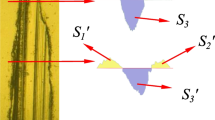Abstract
Grains motion path will be changed in the point grinding process due to the existence of variable angle α. To verify the difference between point grinding and traditional grinding, the moving relationship and coordinate transformation between grinding wheel and workpiece are used to put the grain movement function equivalent to parabola, then point grinding cutting path is concluded. Based on grains distribution on the grinding wheel surface, the 3D geometry simulation topography of workpiece is obtained by extending the effective interference trails along the axial direction. Furthermore, a vitrified bond CBN wheel with a coarse grinding area angle θ is proposed and the principle of design and preparation of these novel grinding wheels are studied. The typical processing parameters are chosen to grind QT700 ladder shaft; the simulation results are verified by using the VHX-1000E microscope and the non-contact 3D surface profilometer to observe the workpiece surface topography and measure the surface roughness. The results indicated that the simulation microstructures coincide well with the experimental measurements and the values of simulation roughness are 0.5 times of experiments. So, the geometric simulation model provided an auxiliary and prediction method for the actual processing topography analysis. In addition, grinding wheels with different θ are used to grind ladder shafts with a series of grinding parameters. The influence trend of inclining angle α, cutting depth ap, axial feeding speed v f and grinding wheel speed v s on surface roughness is obtained. It is concluded that the values of workpiece surface roughness using novel grinding wheel are less than using the traditional grinding wheel under the condition of the same processing parameters.
Similar content being viewed by others
References
Y. D. Gong, G. Q. Yin, C. Wang, X. L. Wen and J. Cheng, Study on the effect of coarse grinding area slope angle on surface quality in point grinding, Advanced Materials Research, 797 (2013) 118–122.
Y. D. Gong, J. Qiu, X. F. Li and C. F. Liu, Study on the correlative mechanism of super high-speed point grinding, J. of Mechanical Engineering, 42 (17) (2010) 172–178.
G. Q. Yin, Y. D. Gong, C. Wang and X. L. Wen, Effects of processing parameters for novel point grinding wheels on surface quality, J. of Northeastern University (Natural Science), 35 (2) (2014) 273–276.
T. A. Nguyen and D. L. Butler, Simulation of precision grinding process, part 1: Generation of the grinding wheel surface, International J. of Machine Tool & Manufacture, 45 (11) (2005) 1321–1328.
T. A. Nguyen and D. L. Butler, Simulation of precision grinding process, part 2: Interaction of the abrasive grain with the workpiece, International J. of Machine Tool & Manufacture, 45 (11) (2005) 1329–1336.
C. Chakrabarti and S. Paul, Numerical modeling of surface topography in superabrasive grinding, International J. Manufacturing Technology, 39 (1-3) (2008) 29–38.
Y. M. Liu, Y. D. Gong, R. Bauer and A. Warkentin, Experimental and numerical investigation into workpiece surface topology in point grinding, Proceedings of the Institution of Mechanical Engineers, Part B: Journal of Engineering Manufacture, 226 (11) (2012) 1793–1800.
Y. D. Gong, B. Wang and W. S. Wang, The simulation of grinding wheels and ground surface roughness based on virtual reality technology, J. of Materials Processing Technology, 129 (1-3) (2002) 123–126.
D. A. Doman, A. Warkentin and R. A. Bauer, Survey of recent grinding wheel topography models, International J. of Machine Tool & Manufacture, 46 (3-3) (2006) 343–352.
X. Agarwal and P. V. Rao, Modeling and prediction of surface roughness in ceramic grinding, International J. of Machine Tool &Manufacture, 50 (12) (2010) 1065–1076.
S. Malkin, Grinding technology theory and application of machining with abrasive, Translated by G. Q. Cai, Y. D. Gong, G. L. Song. Northeastern University Press, Shen Yang, China (2002).
Y. D. Gong, Y. M. Liu, J. Qiu and T. C. Han, Research on Simulation and Experiment for Workpiece Micro-surface in Point Grinding, J. of Mechanical Engineering, 48 (17) (2012) 165–171.
Author information
Authors and Affiliations
Corresponding author
Additional information
Recommended by Editor Haedo Jeong
Yadong Gong is currently a professor and a Ph.D. candidate supervisor at Northeastern University, China. His main research interests include grinding mechanism, digital manufacturing, micro precision process.
Guoqiang Yin is currently a Ph.D. student at Northeastern University, China. His research interests include grinding and precision machining.
Rights and permissions
About this article
Cite this article
Gong, Y.D., Yin, G.Q., Wen, X.L. et al. Research on simulation and experiment for surface topography machined by a novel point grinding wheel. J Mech Sci Technol 29, 4367–4378 (2015). https://doi.org/10.1007/s12206-015-0935-y
Received:
Revised:
Accepted:
Published:
Issue Date:
DOI: https://doi.org/10.1007/s12206-015-0935-y



